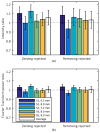Adaptive optics retinal imaging with automatic detection of the pupil and its boundary in real time using Shack-Hartmann images
- PMID: 29048013
- PMCID: PMC5973534
- DOI: 10.1364/AO.56.006748
Adaptive optics retinal imaging with automatic detection of the pupil and its boundary in real time using Shack-Hartmann images
Abstract
Retinal imaging with an adaptive optics (AO) system usually requires that the eye be centered and stable relative to the exit pupil of the system. Aberrations are then typically corrected inside a fixed circular pupil. This approach can be restrictive when imaging some subjects, since the pupil may not be round and maintaining a stable head position can be difficult. In this paper, we present an automatic algorithm that relaxes these constraints. An image quality metric is computed for each spot of the Shack-Hartmann image to detect the pupil and its boundary, and the control algorithm is applied only to regions within the subject's pupil. Images on a model eye as well as for five subjects were obtained to show that a system exit pupil larger than the subject's eye pupil could be used for AO retinal imaging without a reduction in image quality. This algorithm automates the task of selecting pupil size. It also may relax constraints on centering the subject's pupil and on the shape of the pupil.
Figures






Similar articles
-
Pupil tracking with a Hartmann-Shack wavefront sensor.J Biomed Opt. 2010 May-Jun;15(3):036022. doi: 10.1117/1.3447922. J Biomed Opt. 2010. PMID: 20615024
-
Wavefront control in adaptive microscopy using Shack-Hartmann sensors with arbitrarily shaped pupils.Opt Express. 2018 Jan 22;26(2):1655-1669. doi: 10.1364/OE.26.001655. Opt Express. 2018. PMID: 29402037
-
Matching convolved images to optically blurred images on the retina.J Vis. 2022 Feb 1;22(2):12. doi: 10.1167/jov.22.2.12. J Vis. 2022. PMID: 35179553 Free PMC article.
-
In vivo high-resolution retinal imaging using adaptive optics.Semin Ophthalmol. 2010 Sep-Nov;25(5-6):186-91. doi: 10.3109/08820538.2010.518483. Semin Ophthalmol. 2010. PMID: 21090998 Review.
-
Adaptive optics imaging of inherited retinal diseases.Br J Ophthalmol. 2018 Aug;102(8):1028-1035. doi: 10.1136/bjophthalmol-2017-311328. Epub 2017 Nov 15. Br J Ophthalmol. 2018. PMID: 29141905 Free PMC article. Review.
Cited by
-
Adaptive optics imaging of the human retina.Prog Retin Eye Res. 2019 Jan;68:1-30. doi: 10.1016/j.preteyeres.2018.08.002. Epub 2018 Aug 27. Prog Retin Eye Res. 2019. PMID: 30165239 Free PMC article. Review.
-
Ultrafast adaptive optics for imaging the living human eye.Nat Commun. 2024 Nov 29;15(1):10409. doi: 10.1038/s41467-024-54687-z. Nat Commun. 2024. PMID: 39613735 Free PMC article.
-
Telecentric model eye for correction of image distortion in adaptive optics ophthalmoscopes.Biomed Opt Express. 2025 Jun 16;16(7):2767-2791. doi: 10.1364/BOE.565589. eCollection 2025 Jul 1. Biomed Opt Express. 2025. PMID: 40677819 Free PMC article.
-
Cones in ageing and harsh environments: the neural economy hypothesis.Ophthalmic Physiol Opt. 2020 Mar;40(2):88-116. doi: 10.1111/opo.12670. Epub 2020 Feb 4. Ophthalmic Physiol Opt. 2020. PMID: 32017191 Free PMC article. Review.
-
Evolution of adaptive optics retinal imaging [Invited].Biomed Opt Express. 2023 Feb 28;14(3):1307-1338. doi: 10.1364/BOE.485371. eCollection 2023 Mar 1. Biomed Opt Express. 2023. PMID: 36950228 Free PMC article. Review.
References
-
- Liang J, Williams DR, Miller DT. Supernormal vision and high-resolution retinal imaging through adaptive optics. J Opt Soc Am A Opt Image Sci Vis. 1997;14:2884–2892. - PubMed
-
- Roorda A, Romero-Borja F, Donnelly W, III, Queener H, Hebert T, Campbell M. Adaptive optics scanning laser ophthalmoscopy. Opt Express. 2002;10:405–412. - PubMed
-
- Hermann B, Fernández EJ, Unterhuber A, Sattmann H, Fercher AF, Drexler W, Prieto PM, Artal P. Adaptive-optics ultrahigh-resolution optical coherence tomography. Opt Lett. 2004;29:2142–2144. - PubMed
-
- Zhang Y, Rha J, Jonnal R, Miller D. Adaptive optics parallel spectral domain optical coherence tomography for imaging the living retina. Opt Express. 2005;13:4792–4811. - PubMed
-
- Niu S, Shen J, Liang C, Zhang Y, Li B. High-resolution retinal imaging with micro adaptive optics system. Appl Opt. 2011;50:4365–4375. - PubMed
MeSH terms
Grants and funding
LinkOut - more resources
Full Text Sources
Other Literature Sources

